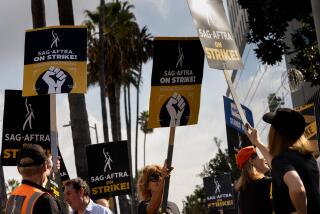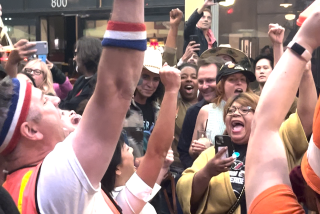Strike Looking More Like a Monster Epic
- Share via
I grew up in an era of labor violence, when strikes were bloody but simpler to understand. At the very simplest level, the song from “Pajama Game”--”Seven-and-a-Half Cents”--said it all. You asked a dime an hour more, were offered a nickel, settled midway between and everybody went back to work.
It was seldom quite that simple. In the earliest struggles that I knew about, the right to strike was itself at issue. There were the sit-down strikes, the strikebreakers with truncheons, the lines of police or troops protecting the status quo, as it often seemed. There were the placards and the bloodied heads, the waves of workers running along the factory walls, the newsreel commentaries which viewed the disorder with indignant alarm.
These weeks it has been impossible to follow the dismaying stalemate of the Writers Guild of America versus the Alliance of Motion Picture and Television Producers without remembering the bitter history of unionism in Hollywood.
All the victories that led to the establishment of the Writers Guild itself and the other guilds and unions were hard won--not least because the salaries already being paid to the best-off writers, directors and actors looked stratospheric to a coal miner or a steelworker.
Making the best- and least-paid in the industry agree on their common cause was an early problem, and it has obviously not gone away.
The issues then had to do not only with minimum dollars for the least-rewarded writers, for example, but with fair and protected credit for the work done. In time it became clear that the gains benefited both sides, bringing a measure of order and stability to a young and chaotic industry.
The Academy of Motion Picture Arts and Sciences nearly foundered in its early days because it was perceived as an attempt at a company union to contravene the moves to organize. There were wholesale defections from the academy during the formative years of the guilds, before the academy became the nonpolitical organization it is now.
What is clear about the present strike is that nothing about it is simple. It is larger than itself, which is one bedeviling problem.
The writers cannot be given more than the directors received or everybody will want more, including the directors the next time around.
What is being asked and not given is, at that, a very long way from 7 1/2 cents an hour. The formulas for residuals, even in the strike documents, makes the 1040 tax-form instructions read like a Dick and Jane primer. It is a strike being fought on principles, and on estimations of the way the TV world is going, may go, may not go.
The complexity of the still-divisive points plus the fact that only fragments of information emerge from the news blackout make it impossible to know which came first, the immobility of the alliance or the intransigence of the guild, or was it the intransigence of the alliance or the immobility of the guild?
The feeling among many guild members is that the alliance, sensing an anti-labor trend in the society as well as in the government (symbolized by the 1981 dismissal of the PATCO air traffic controllers), is determined to eviscerate or destroy the guild.
The alliance hotly denies such intentions, arguing that the guild serves valuable housekeeping functions, as in the matter of pensions and health funds. (This can be read as a fairly diminishing estimate of the guild.)
The alliance’s hard line as perceived has unquestionably held the ranks of the guild together--to an astonishing degree in light of the guild’s disarray during its last strike three years ago.
What is manifestly and urgently required is a neutral, respectable and effective third force to get the two sides together again and break the stalemate. The federal mediator is neutral and respectable but has so far been unable to budge the principals, though it is possible he may yet be able to.
Several face-saving proposals involving mutual concessions have been offered from outside and inside the negotiations. Why and by whom these have all been rejected is not certain. Who the third force might be if not the federal mediators--church, state or academia--is not certain either, but time is running out fast.
In past strikes, Lew Wasserman of MCA Inc. apparently served this conciliatory role behind the scenes, but MCA is now among the hard-liners. In all events, the cohesion and the agreed leadership of the industry are not what they were in pre-conglomerate days. Part of the problem this time may indeed be that none of the companies feels potent enough to make the conciliatory first (or last) step.
What is also certain now is that it is no longer a strike either side can “win” in the short run or the long run. All that can be hoped for now is an end to the economic distress the strike is causing on all sides and a minimizing of the bitterness that already exists.
According to an amused note in the Listener from London, American companies have been recruiting writers there for several weeks. This confirms threats voiced by the alliance. The alternative to an early settlement will all too evidently be a kind of ugliness Hollywood that hasn’t seen in a long time, and with no happy ending in the last reel.
The alliance and the guild have got to be saved from themselves. The question is by whom?
More to Read
Only good movies
Get the Indie Focus newsletter, Mark Olsen's weekly guide to the world of cinema.
You may occasionally receive promotional content from the Los Angeles Times.










